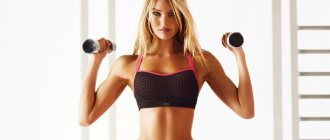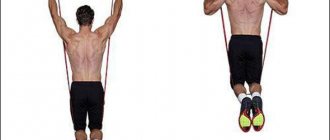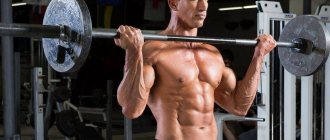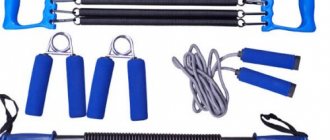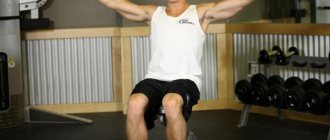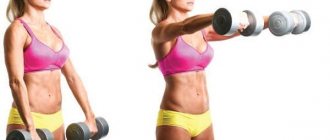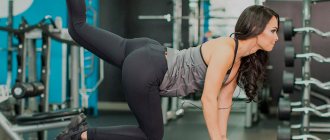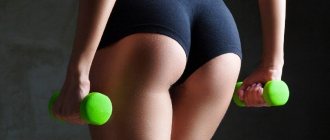The structure and characteristics of the shoulder muscle
The shoulder is conventionally divided into three bundles: anterior, middle and posterior. As a rule, the front bundle is the strongest and largest; it is strained in many exercises: bench press, dips, dumbbell press, etc.
The middle and rear beams are always lagging behind and if you do not pay attention to them, you can get the effect of “sloping” shoulders, moreover, a visual effect of stooping appears. The shoulder deltas are responsible for many functions. Every day, in everyday life, we put a lot of stress on our shoulders, so it’s not so easy to build up your shoulders if you don’t understand their structure and features.
The shoulders are very resilient; if 10 repetitions are enough for the pectoral muscles, then 15 may not be enough for the deltoids, even with heavy weights for you. You've probably noticed that after hard training of most muscles, they can ache for several days, but your shoulders don't. This is a training problem; most of the basic programs that are on the Internet are designed to strengthen the shoulder muscles, and not to grow them.
Goal: development of the anterior deltoid bundle
If you're training your chest, you probably already have well-developed front deltoids. After all, they work in all chest exercises, especially those performed on an incline.
But relatively weak front delts will keep you from getting a bigger chest, so here's a workout that focuses on the front delts that you can use instead of a regular shoulder workout.
Divide your workouts between chest and shoulders, especially focusing on the front deltoids, leaving at least 48 hours between them to allow them to fully recover between sessions.
Workout 6: Focus on the front delts
- Standing barbell press – 4 sets of 8-12 reps (rest 2 minutes)
- Arnold press – 4 sets of 8-12 reps (rest 2 minutes)
- Raising dumbbells in front of you - 3 sets of 10 reps (rest 60-90 seconds)
- Raising your arms in front of you from the lower block - 3 sets of 10-12 repetitions (rest 60-90 seconds)
Principle of shoulder training
All exercises in the gym must be performed technically, this is my motto. Shoulder training should be technical in the square. “Cheating” has its place, but not in this exercise. The shoulders do not need large weights, there are a number of reasons for this:
- High injury risk.
- More weight means worse execution technique.
- The shoulder muscles are durable, but not very strong; other muscle groups are involved.
- Bodybuilding is not powerlifting, you need to forget about weights and don’t be shy about lifting small weights.
It is better to do shoulder training on the same day as trapezius training, so you will beautifully outline the top of your torso, plus the deltoids and trapezius are a kind of antagonist muscles.
How to build sculpted shoulders? Shoulder exercises and supersets
Shoulder muscles: anatomy
The deltoids, or deltoids, are located just above the biceps where the arm attaches to the body. The term “shoulder muscles” most often refers to the deltoid muscles, as well as partly the trapezius muscles.
The deltoid muscle itself consists of three large bundles (posterior, anterior and middle), arranged in the shape of a triangle. The middle delta has the largest volume, so it is, as a rule, given priority in training.
Best Shoulder Exercises
It is believed that shoulders are easy to shape, but difficult to add volume. Typically, training begins with basic shoulder presses (military barbell press or Arnold press with dumbbells), which are the main exercises for making the shoulders massive. We talked in more detail about shoulder exercises earlier.
The back of the deltas is worked out with dumbbell lifts in an inclined position, the front with dumbbell lifts in front of you. For all of these exercises, there are analogues performed on simulators, but working with free weights is more effective.
Broad shoulders: secrets of technique
Since fast muscle fibers predominate in the shoulder muscles, the so-called “pumping” is excellent for their growth, which consists of performing exercises with low weight and a high number of repetitions (about 12-15).
At the beginning of delt training, one or two basic exercises are performed with increasing working weight in each approach, then isolated exercises come. For beginners, intensive work with light weights is suitable, for advanced ones - supersets and dropsets.
The most common mistakes
Despite the fact that shoulder training does not require large working weights, many are chasing numbers exclusively, putting joints and ligaments in danger. Remember that the shoulder is quite easy to injure, but it is extremely difficult to heal the injury completely.
Also, do not overestimate the importance of the front and rear deltoids. Typically, each of these groups requires only one exercise. The main emphasis should be on training the middle delta, since it is this that forms voluminous and powerful shoulders.
Supersets for shoulders
A superset is a combination of two different exercises by alternating repetitions of each, when first the first is done, then the second, then the first again - an ideal technique for creating pumped and sculpted shoulders.
It is most effective to combine the front and rear deltoids, or two exercises for the middle deltoids. In addition, as an advanced training technique, you can use trisets, working all the deltoids in one intense approach.
Dropsets: the right technique
The “dropset” - reducing the working weight and increasing the number of repetitions from approach to approach - also has a positive effect on the growth of shoulder muscles. In each approach, up to 20-25% of the weight is dropped, a total of 6-8 approaches are performed without a break.
The drop set is the best completion of shoulder training, and, as a rule, each drop set is performed on a different set of deltoids. However, it is important to note that this technique should only be used by advanced practitioners.
Combination of training with other muscles
The deltoid muscles are considered to be a fairly independent muscle structure that does not involve antagonist muscles. However, their training can be combined with training of not all muscle groups.
Shoulders do not combine well with training the back and chest muscles, since in all cases powerful arm work is required. Most often, “shoulder day” is leg day. In addition, shoulders can be combined with biceps or triceps training.
***
The deltoid muscles develop from high-quality blood pumping during strength training. The quality of this pumping is determined by the correct execution technique. It is recommended to first practice this technique, then increase the working weight.
Super sets in shoulder training
There are many different shoulder training programs. Everyone has their own characteristics of the body and muscle structure, I’m not saying that this program is suitable for everyone, but it’s worth trying. In my case, the response to the muscles is excellent. Now a little specifics.
To make the shoulder as similar to the “Core” as possible, my big shoulder workout includes 3 exercises.
- Bench press standing behind the head (light weight 50% of the maximum), (15 times)
- Barbell row with the same weight to the chin (15 times)
- Swing dumbbells to the sides (15 times)
All 3 exercises are done without interruption. It is not necessary to reach failure. To begin, select a weight so that you have enough strength to perform all three exercises 15 times in 3 sets. It may take a whole workout, but it’s better to sacrifice a little blood and clearly understand what weights will work for you. I repeat, there is no need to rush and, at any opportunity, increase the weight of the barbell, take heavy dumbbells, you should be interested in the execution technique, not the weight.
Goal: relief of the deltoid muscles
Lifting light weights for high reps is no longer considered the best approach for getting deltoid definition.
This workout focuses on increasing shoulder size (moderate weight, moderate reps) and then high training volume of work combined with supersets to increase the number of calories burned both during and after the workout (called excess post-exercise oxygen consumption or EPOC , English excess postexercise oxygen consumption - the amount of oxygen required to oxidize the under-oxidized metabolic products accumulated in the body during intense muscular work, also called oxygen debt)
Workout 2: Deltoid Definition
Normal execution
- Seated barbell press – 4 sets of 8-12 reps (rest 2 minutes)
Superset
- Standing dumbbell lateral raises – 3 sets of 10-12 reps (no rest)
- Seated bent over raises with dumbbells – 3 sets of 10-12 reps (rest 60-90 seconds)
Superset
- Raising your arms in front of you from the lower block – 3 sets of 10-12 repetitions (without rest)
- Vertical row from the lower block - 3 sets of 10-12 reps (rest 60-90 seconds)
Superset
- Arm raises in the Peck Deck simulator – 3 sets of 10-12 repetitions (without rest)
- Lateral raises using an expander or rubber band - 3 sets of 10-12 reps (rest 60-90 seconds)
Technique:
Standing overhead press . The barbell should be held slightly wider than your shoulders so that your elbows are parallel to the floor in the middle of the movement. There is no need to lower the barbell low, do not lower the barbell onto your shoulders.
Barbell row to the chin: the barbell can be taken either straight or curved, in fact there is no fundamental difference. Shoulder-width grip. As you move, try to move your elbows back to lift the weight with your deltoids.
Swing dumbbells to the sides. The weight in the 3rd exercise will not be large at all, believe me, the shoulders will be very tired, especially in the 3rd set. The key word in this exercise is “to the sides”, neither forward nor backward. This way you will be able to delineate the delta from the biceps and triceps, which will visually increase the volume of the delta.
This program is suitable for people with any level of fitness, the only difference will be in the weights. Try to use just such super sets on the day of shoulder training and in a month, or maybe earlier, you will see an increase in the volume and quality of deltoids.
Goal: development of the middle deltoid fascicle
To make your shoulders look wider, you need to emphasize your middle deltoids. This in turn helps create a V-shaped torso, creating the illusion of a narrow waist. Of course, the key to this kind of training is to do more exercises that target the middle deltoids.
In addition to the core exercises, you can use different angles of isolation movements for different training stimuli and perform such exercises with a moderate body displacement earlier in the training when your strength level is highest.
You can alternate this workout in your weekly split with a more balanced delt workout that hits all three heads evenly (such as Workout 1).
Workout 4: Focus on Middle Delts
- Standing barbell press – 4 sets of 8 reps (rest 2 minutes)
- Vertical barbell row – 3 sets of 8-10 reps (rest 60-90 seconds)
- Side dumbbell raise with one arm while standing with a slight bend to the side - 3 sets of 10 repetitions with each arm (rest 60-90 seconds)
- Standing dumbbell lateral raises – 3 sets of 10-12 reps (rest 60-90 seconds)
